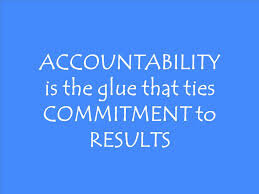No Get Out of Jail Free Card Here
To hold accountable. To be accountable. Do your team members commit to both? Value both? This concept should not just be top-down but shared across teammates, departments, and management teams.
To be accountable. At its finest. When an employee says they will do something - they do it and on time. They appreciate that other team members are dependent on the results of their work. They are open and communicative about their progress and any challenges because they know it has a direct impact on the other members’ ability to achieve their own work.
To hold accountable. Well, that one can be a bit more challenging for managers. In some cases, they fear uncomfortable conversations, in other cases, it might just be a case of getting caught up in the day-to-day and not remembering to follow up. And, I’m sure a host of other reasons.
Here’s the Problem with That
When there isn’t accountability, it snowballs. Or becomes an avalanche.
If someone is underperforming – not getting work done, getting it done late, it’s sloppy, they are showing up to meetings late or unprepared, …. etc. the other team members who are left to pick up the slack may grow resentful and frustrated. If they can’t get their work done and feel it reflects poorly on them (maybe because someone is misplacing the blame – even worse!!), that resentment builds.
If underperformance is left unchecked, it becomes the norm. When employees are not encouraged and expected to perform at their highest levels, they become disengaged. Adopting a “why bother” attitude. Morale slips. Nobody trusts anyone else to do their job. Work becomes siloed creating inefficiencies, details fall through the cracks, and collaboration cracks.
Maybe you let it slide for one person or apply it inconsistently, the rest of your team may think you are showing favoritism, or you are weak. They may lose respect for you as a leader becoming further disengaged.
The more resentment, frustration, and disengagement à the higher employee turnover (and poor business performance – double whammy to the bottom line)
A Framework for Accountability
In his book, Good Authority, Jonathan Raymond gives us a framework to work with – the accountability dial. This is just one approach but a good one. It organizes the enforcement concept in my brain. He sets out 5 different levels of accountability.
#1 The Mention. Real-time feedback. You are calling out an observation about a specific behavior and trying to understand why the person took that action or performed certain tasks. The goal is to understand why. Not to judge, make assumptions or project. You are showing concern. What is not working? Do you need more support? Resources? Was I not clear or are my expectations unrealistic? Walk me through your thought process here or how you went about “X”?
All feedback is valuable, but feedback that is specific, contextualized and timely is powerful in creating immediate change. This is at the heart of accountability because this is where you can nip it in the bud.
Not to mention, when you show that you care about their success, employees are more engaged and want to follow through and do their best. If they think, “oh no, I’m falling behind or this isn’t working, and nobody cares …” it’s easy to feel ignored and devalued. Out the door they will go.
The goal at this stage – or all stages really – is to open a dialogue. Accountability is not about instilling fear. Making threats. Criticizing employees or their work.
#2 The Invitation. An informal chat. Maybe you have noticed a certain behavior a few times and so far, no change. It’s important to get them to see the pattern. Maybe they think – fine that was a one-off won’t happen again and aren’t aware that the behavior is perpetuating. It’s an invitation to see the problem for what it is.
#3 The Conversation. The dreaded “we need to talk” – eeeek. No. No. this isn’t a breakup. Not yet. Now you are really focused on the impact to the rest of the team and the business. This goes beyond the “why” and the individual fix and speaks to the bigger impact that is unacceptable. Aka. Houston, we have a problem.
#4 The Boundary. Time to lay out some consequences. What might happen if this doesn’t improve. We have not reached the level of – you’re fired. Maybe they lose some privilege they have or the chance to work on a new product or feature.
A word on consequences, when building a culture of accountability remember there should be positive and negative consequences that reinforce accountability. If someone delivers on their commitments, maybe you let them work on an interesting project outside their wheelhouse, attend some training, present at a meeting, or enjoy flexible hours.
#5 The Limit. It’s the final warning really. As some point, it may just not work out - that person chooses not to step up to the plate, or the severity of the initial behavior is just unacceptable.
Accountability is a good thing for everyone because it builds trust. It requires great delegation skills but also a commitment to certain values. An appreciation for personal responsibility and integrity.

